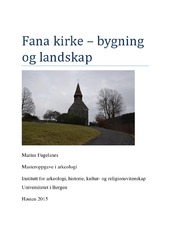| dc.description.abstract | Denne masteroppgaven er en studie middelalderkirken på Fana som en bygning og som et kirkested. Kirkens lange og varierende bygningshistorie, dens geografiske plassering og dens monumentale størrelse har lagt grunnlaget for at jeg valgte nettopp denne kirken. Fana kirke var i høymiddelalderen et kongelig kapell, og jeg har sammenlignet den med to andre slike kapeller: St. Ludvigs kapell på Tyssøy og Olavskirken på Avaldsnes. Mine problemstillinger var: Hvordan kan Fana kirke ha sett ut i middelalderen, og endret den seg da den ble kongelig kapell? Hvordan har ombygging og restaureringer påvirket Fanakirkens senere utseende?  Hvordan fremstår Fana kirke sammenlignet med andre kongelige kapell, og da særlig de kongelige kapellene på Tyssøy og Avaldsnes? Hvilken status hadde kirken og endret den status over tid? Hva særmerker landskapet rundt Fana kirke, sammenlignet med Avaldsnes og Tyssøy?I hvilken grad er kirken anlagt på et gammelt rituelt sted eller et nytt' og uavhengig sted?Hvem kan ha stått bak anlegget av kirkestedet? | en_US |
| dc.description.abstract | This master thesis concerns a study of the medieval church of Fana and its building history and also related to the cultural landscape surrounding the church. In the High Middle Ages the church achieved a special status, as a royal chapel, one of 14 in medieval Norway. The church is located in rural environments to south of the city of Bergen in the county of Hordaland in western Norway. The research questions relate to its age, building history in a biographical and retrospective perspective following the church's layout and architectural elements from the present backswords in time to its origins, including rebuilding and restoration processes in the twentieth and nineteenth centuries. The church is also compared with two other churches in western Norway with the same status to see the church in a broader perspective. The overall aim has been to clarify and explain these processes contextually and over time, and why it got a special status. Theoretically, I have been inspired by the structuration theory related to the reciprocal relation between structures, society and actors, developed by Anthony Giddens to better understand how the church as a structure was affected by the surrounding society, various actors over time, and vice versa. Methodologically, the study of the surrounding landscape has been carried out as a so-called visual landscape analysis. The study has shown that it has gone through several changes over time. Some have been caused by changes in its first centuries, where the nave was built in the Roman style and the chancel was built in Gothic style. Some changes seem to be caused by the new status achieved by the King, others due religious and liturgical changes, and others to fire and destruction. In 1870-71 rebuilding of the medieval church altered and destroyed many of the original constructions and outlook. Negative feedback not only from antiquarian, but people generally caused a new restoration in order to restore the medieval structure, but also adapting it to meet new demands. The study shows that the church had a significant position in the community of Fana and well as the county, being situated a regional border with in the county, dividing it in two. It was built around 1150 close this border marked by the Fana River as well as standing stones and prehistoric grave mounds, indicating that the church was built on a prehistoric ritual site, and a central place in the community. All the three churches were built in different landscapes, but all on strategic places, where the King seems to have been the founder of all these three churches, where especially the churches at Fana and Avaldsnes have most in common - large and monumental, and built in stone, at strategic places in the landscape. | en_US |
